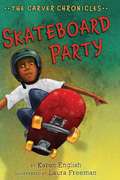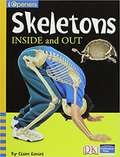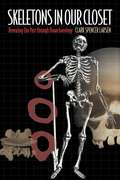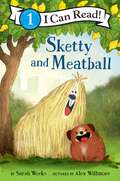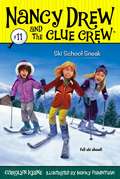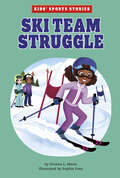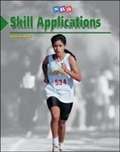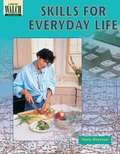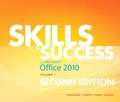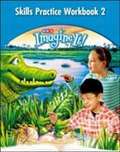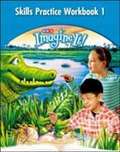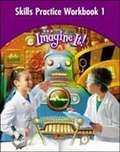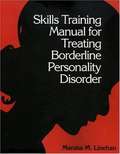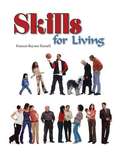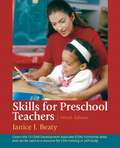- Table View
- List View
Skateboard Party (Carver Chronicles #2)
by Karen English Laura FreemanRichard can't wait to show off his flat-ground Ollies at a friend's birthday party at the skate park, but a note home from his teacher threatens to ruin his plans. He really meant to finish his assignment on howler monkeys, but he just got . . . distracted. If only he could focus on his schoolwork, he wouldn't get into this kind of trouble! Can Richard manage to put off getting the note signed (and facing the consequences) until after the party, or will the deception make things even worse? Nikki and Deja fans and their male peers are sure to recognize themselves and their classmates in this humorous school story.
Skateboards from the Sea (Fountas & Pinnell Classroom, Guided Reading)
by K. L. FosterNIMAC-sourced textbook. A TALE OF TRASH. Most people look at an old fishing net and see…an old fishing net. Three friends who love the ocean see something quite different. Find out how they turn old nets into something new.
Skeletons Inside and Out
by Claire DanielComplete Classroom Library includes one each of the following: Math Library Science Library Social Studies Library Content Area Classroom Libraries include: 1 display box containing 10 6-packs (60 little books) 1 Teacher Resource Portfolio 1 Assessment Book (where available) Classroom Library Add-on Packs include 1 copy of each title from the social studies, science, and math libraries. Add-On Packs include 1 copy of each title.
Skeletons in our Closet: Revealing Our Past through Bioarchaeology
by Clark Spencer LarsenThe dead tell no tales. Or do they? In this fascinating book, Clark Spencer Larsen shows that the dead can speak to us--about their lives, and ours--through the remarkable insights of bioarchaeology, which reconstructs the lives and lifestyles of past peoples based on the study of skeletal remains. The human skeleton is an amazing storehouse of information. It records the circumstances of our growth and development as reflected in factors such as disease, stress, diet, nutrition, climate, activity, and injury. Bioarchaeologists, by combining the methods of forensic science and archaeology, along with the resources of many other disciplines (including chemistry, geology, physics, and biology), "read" the information stored in bones to understand what life was really like for our human ancestors. They are unearthing some surprises. For instance, the shift from hunting and gathering to agriculture approximately 10,000 years ago has commonly been seen as a major advancement in the course of human evolution. However, as Larsen provocatively shows, this change may not have been so positive. Compared to their hunter-gatherer ancestors, many early farmers suffered more disease, had to work harder, and endured a poorer quality of life due to poorer diets and more marginal living conditions. Moreover, the past 10,000 years have seen dramatic changes in the human physiognomy as a result of alterations in our diet and lifestyle. Some modern health problems, including obesity and chronic disease, may also have their roots in these earlier changes. Drawing on vivid accounts from his own experiences as a bioarchaeologist, Larsen guides us through some of the key developments in recent human evolution, including the adoption of agriculture, the arrival of Europeans in the Americas and the biological consequences of this contact, and the settlement of the American West in the eighteenth and nineteenth centuries. Written in a lively and engaging manner, this book is for anyone interested in what the dead have to tell us about the living.
Sketty and Meatball (I Can Read Level 1)
by Sarah Weeks"A pair we would happily hang out with again." —Kirkus ReviewsFrom Sarah Weeks, creator of the beloved series Mac and Cheese, comes Sketty and Meatball, a Level One I Can Read about two irrepressible dog best friends.Best friends Sketty and Meatball do everything together. They play together. They bark together. If Sketty sniffs a flower, Meatball sniffs a flower too. If Meatball wags his tail, Sketty’s tail is wagging too.Young readers will be delighted by two pals called Sketty and Meatball, who happen to look quite a bit like their names.Sketty and Meatball is a Level One I Can Read book, which means it’s perfect for children learning to sound out words and sentences. Whether shared at home or in a classroom, the short sentences, familiar words, and simple concepts of Level One books support success for children eager to start reading on their own.
Ski School Sneak (Nancy Drew and the Clue Crew #11)
by Carolyn Keene Macky PamintuanSnowy situation! <P><P>Nancy, George, and Bess are on a ski trip! They are having tons of fun, and Bess proves a natural for the slopes. She even wins a special award! But when the ski supply room is suddenly trashed, all eyes turn to Bess. It looks like she's a suspect this time around. <P><P> Nancy is sure Bess is innocent, but how can she prove it? And just when it seems things can't get any worse, a snowstorm closes the road home. The Clue Crew is trapped at the ski lodge! Can Nancy find a way to clear Bess's name...and will they ever get home?
Ski Team Struggle (Kids' Sports Stories)
by Dionna L. MannMaddie loves being on the ski team with her friend Sarah. Sarah is the fastest skier on the team. Maddie wants to beat Sarah’s time but is having trouble. She takes her frustrations out on Sarah. Will Maddie realize that she needs to stop comparing herself to others before she ruins her friendship with Sarah?
Skills Applications Student Book
by Siegfried Engelmann Linda Carnine Gary Johnson Linda MeyerSkills Applications is designed to help students who have difficulty in reading fluently. It lists sounds in each lesson and uses them in a passage for the student to read and practice.
Skills For Everyday Life
by Terry Overton Jane M. CoeIncludes comprehensive teacher materials and step-by-step application activities.
Skills For Success With Office 2010, Volume 1
by Shelley Gaskin Robert L. Ferrett Kris Townsend Catherine Hain Alicia VargasSkills for Success is written with today's students in mind. The book provides step-by-step guidance in an easy-to-use format. Each skill is presented on a two-page spread with clearly numbered steps and clear instruction. Key skills required to get started with Microsoft Office are covered, giving readers a complete introduction to the core tools.
Skills Practice Workbook, Level 3, Book 1
by Mcgraw HillImagine It!: Skills Practice Workbook 1 Grade 3
Skills Training Manual for Treating Borderline Personality Disorder
by Marsha M. LinehanA vital component in Dr. Linehan's comprehensive treatment program, this manual details precisely how to implement the skills training procedures and includes practical pointers on when to use the other treatment strategies described.
Skills for Living
by Frances Baynor Parnell Joyce Honeycutt WootenSkills for Living is a comprehensive text designed to help you meet the challenges of daily life with confidence. It will help you develop a range of skills related to interpersonal and family relationships, healthy living, getting and keeping a job, foods and nutrition, management, clothing, and housing.
Skills for Personal and Family Living
by Frances Baynor Parnell Joyce Honeycutt WootenComprehensive Family and Consumer Sciences text helps secondary level students meet the challenges of their daily lives with confidence. It will help you develop a range of skills related to interpersonal and family relationships, getting and keeping a job, management, healthy living, foods and nutrition, clothing, and housing.
Skills for Preschool Teachers
by Janice J. BeatyFor over two decades, Skills for Preschool Teachers has prepared teachers, teaching assistants, college students, classroom volunteers, and CDA candidates to work with children three-to-five years of age in preschools, center-based child care, Head Starts, and pre-kindergartens. The skills for working with young children are presented in 13 easily-readable, fact-filled chapters, each of which is based on one of the CDA "functional areas": safe, healthy, learning environment, physical, cognitive, communication, creative, self-concept, social, guidance, family, program management, and professionalism. Its use of practical checklists for observing children and the classroom environment has been a hallmark of this text, as well as its use of the latest children's picture books as lead-ins to every curriculum area covered. Practitioners will appreciate the appropriate NAEYC Program Standards in every chapter, as well as a section on inclusion and how to help children with disabilities succeed in classroom activities.

